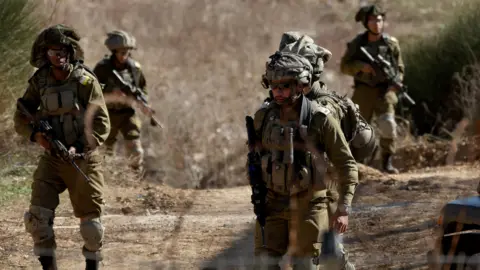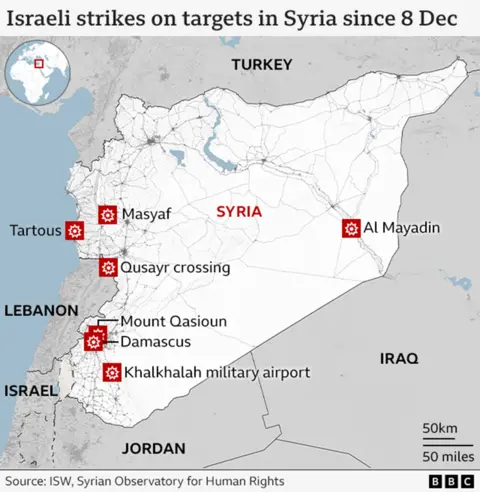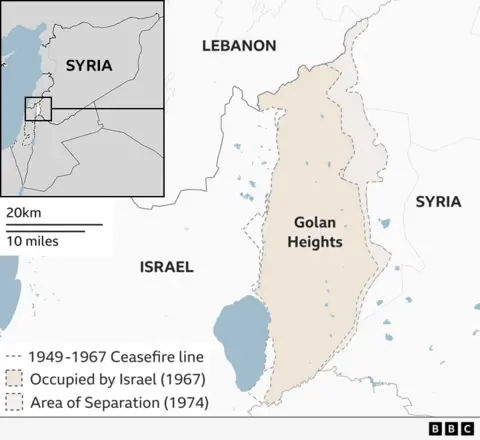Israel says it has struck suspected chemical weapons sites in Syria

 EPA
EPAIsrael has confirmed it will attack Syria to target suspected chemical weapons and missile sites.
Gideon Saar, who is the country’s foreign minister, said this was to stop weapons falling into the “hands of extremists” following the overthrow of the Assad regime.
Media reports suggest that there have been a number of Israeli airstrikes over the past two days, including on an area in Damascus said to be used for the development of rockets by Iranian scientists.
The Israeli airstrikes come as the UN’s chemical watchdog warns authorities in Syria to ensure that a suspected chemical weapons stockpile is safe.

The Syrian Observatory for Human Rights (SOHR), a monitoring group based in the UK, said on Monday that the Israeli army carried out night strikes in several coastal and southern areas of Syria.
“From the first hours after the announcement of the fall of the former regime, Israel began airstrikes, deliberately destroying ammunition storage facilities,” the newspaper said.
According to the UN chemical body, the Organization for the Prohibition of Chemical Weapons (OPCW), a chemical weapon is a chemical used to intentionally cause death or harm through its toxic properties, externally.
The use of chemical weapons is prohibited under international humanitarian law regardless of the presence of legitimate military targets, as the effects of such weapons are indiscriminate in nature.
It is not known where or how many chemical weapons Syria has, but former President Bashar al-Assad is believed to have kept them and his announcement was incomplete.
Syria signed the OPCW’s Chemical Weapons Convention in 2013, a month after a chemical weapons attack on the suburbs of the capital, Damascus, involving the nerve agent sarin and left more than 1,400 people dead.
The gruesome images of the victims writhing in agony shocked the world. The West said the attack could only have been carried out by the government, but Assad blamed the opposition.
Although the OPCW and the UN have destroyed all 1,300 tons of chemical weapons claimed by the Syrian government, chemical weapons attacks in the country continue.
A BBC analysis in 2018 confirmed that between 2014 and 2018, Chemical weapons were used in the Syrian civil war at least 106 times.
On Monday, the OPCW said it contacted Syria “with the aim of emphasizing the utmost importance of ensuring the safety and security of all chemical weapons-related facilities” in the country.
Also on Monday, the Israeli military released images of its soldiers crossing the Israeli-occupied Golan Heights into a blockaded area in Syria where UN peacekeepers are stationed.
It comes a day after Israeli Prime Minister Benjamin Netanyahu announced that the military had done so temporarily seized control of the so-called Area of Separation, said the 1974 withdrawal agreement with Syria “collapsed” when rebels took over the country.
The Golan Heights is a rocky plateau about 60 kilometers (40 miles) southwest of Damascus.
Israel captured the Golan from Syria at the end of the 1967 6-Day War and annexed it in 1981.
Speaking at a press conference on Monday, Saar said the Israel Defense Forces (IDF) was taking “limited and temporary action” taken for “security reasons”.
He also said that Israel is not interested in interfering in Syria’s internal affairs and is only focused on protecting its citizens.
Meanwhile Defense Minister Israel Katz said Israel’s military will “destroy powerful weapons” – including missile and air defense systems.

Israel’s latest moves come after Syrian rebels seized the capital, Damascus, and toppled Bashar al-Assad’s regime. He and his father had been in charge of the country since 1971.
Militants led by the Islamist opposition Hayat Tahrir al-Sham (HTS) entered Damascus early on Sunday, before appearing on state television to announce that Syria was now “free”.
On Sunday, Netanyahu called the fall of the Assad regime “a historic day in the Middle East”.
The Assad regime received heavy support from Hezbollah and Russia in the brutal civil war. With Hezbollah involved in the Israel-Gaza war and airstrikes across the border between Israel and Lebanon, and Russia spending huge resources on its offensive in Ukraine, HTS, along with other rebel groups in Syria, managed to hijack the event and eventually capture large areas of Syria.
During the 2011 Syrian uprising, Israel made the calculation that Assad, despite being an ally of Iran and Hezbollah, was a better bet than his own regime.
On Sunday, Netanyahu stressed that Israel will “send a hand of peace” to the Syrian people who want to live in peace with Israel.
He said the presence of the IDF in the buffer zone is a “temporary defensive zone until a suitable plan is found”.
“If we can establish neighborly relations and peaceful relations with the new forces emerging in Syria, that is our desire. But if we don’t do that, we will do whatever is necessary to protect the State of Israel and Israel’s border,” he said.
Israel is likely to be particularly sensitive to the Golan Heights, as the family of HTS leader Abu Mohammed al-Jawlani has roots there. Thousands of Israeli settlers now live in the area alongside around 20,000 Syrians, mostly Druze, who remained after its capture.
Israeli strikes in Syria are nothing new. It has previously admitted to carrying out hundreds of strikes in recent years against targets in Syria it says are linked to Iran and allied armed groups such as Hezbollah.
Israeli strikes in Syria are reported to be more frequent since the war in Gaza began in October 2023, in response to attacks on northern Israel by Hezbollah and other groups in Lebanon and Syria.
Just last month, the Syrian Observatory for Human Rights (SOHR), a UK-based monitoring group, reported that strikes had hit a weapons depot and other sites in an area near Palmyra where families of pro-Iran fighters were located. , 68 Syrians and foreigners were killed.
Source link




